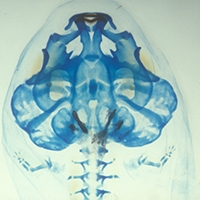Citation:
| 2 MB |
Date Published:
JanAbstract:
Ziermann, J.M., Infante, C., Hanken, J. and Olsson, L. 2011. Morphology of the cranial skeleton and musculature in the obligate carnivorous tadpole of Lepidobatrachus laevis (Anura: Ceratophryidae). Acta Zoologica (Stockholm) 00:112. Lepidobatrachus laevis (Ceratophryidae: Ceratophryinae) is a bizarre frog endemic to the Chacoan desert of central South America. Its tadpole is an obligate carnivore that can catch and consume live prey nearly its own size. Morphological adaptations associated with this unique feeding mode, including the larval skull anatomy and associated cranial musculature, have only been partly described. We studied the head of Stages 2627 larvae using gross dissection, immunohistochemistry, and standard histology. Derived features of this tadpole compared to the microphagous, herbivorous larvae of most other anurans include simplified chondrocranial cartilages and very robust jaw muscles. The mm. suspensorio- et quadratoangularis do not take their origin from the processus muscularis of the palatoquadrate, as in most other tadpoles, but instead originate from the corpus of the palatoquadrate caudal to this process. The jaw levators are unusually large. The tadpole of Ceratophrys, another member of the ceratophryine clade, also consumes large animal prey, but its morphology is very different. It probably has evolved independently from a generalized, mainly herbivorous tadpole similar to the larva of Chacophrys, the third ceratophryine genus. Most specialized features of the larval head of Lepidobatrachus laevis are adaptations for megalophagyingestion of whole, very large animal prey.
Notes:
054KFTimes Cited:3Cited References Count:33






